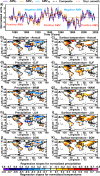Early warning signal for a tipping point suggested by a millennial Atlantic Multidecadal Variability reconstruction
- PMID: 36056010
- PMCID: PMC9440003
- DOI: 10.1038/s41467-022-32704-3
Early warning signal for a tipping point suggested by a millennial Atlantic Multidecadal Variability reconstruction
Abstract
Atlantic multidecadal variability is a coherent mode of natural climate variability occurring in the North Atlantic Ocean, with strong impacts on human societies and ecosystems worldwide. However, its periodicity and drivers are widely debated due to the short temporal extent of instrumental observations and competing effects of both internal and external climate factors acting on North Atlantic surface temperature variability. Here, we use a paleoclimate database and an advanced statistical framework to generate, evaluate, and compare 312 reconstructions of the Atlantic multidecadal variability over the past millennium, based on different indices and regression methods. From this process, the best reconstruction is obtained with the random forest method, and its robustness is checked using climate model outputs and independent oceanic paleoclimate data. This reconstruction shows that memory in variations of Atlantic multidecadal variability have strongly increased recently-a potential early warning signal for the approach of a North Atlantic tipping point.
© 2022. The Author(s).
Conflict of interest statement
The authors declare no competing interests.
Figures






References
-
- Ting M, Kushnir Y, Saeger R, Cuihua L. Forced and internal twentieth-century SST trends in the North Atlantic. J. Clim. 2009;22:1469–1481. doi: 10.1175/2008JCLI2561.1. - DOI
-
- Mann ME, Steinman BA, Miller SK. On forced temperature changes, internal variability, and the AMO. Geophys. Res. Lett. 2014;41:3211–3219. doi: 10.1002/2014GL059233. - DOI
-
- Knight J, Folland C, Scaife A. Climate impacts of the Atlantic multidecadal oscillation. Geophys. Res. Lett. 2006;33:L17706. doi: 10.1029/2006GL026242. - DOI
Publication types
MeSH terms
LinkOut - more resources
Full Text Sources
Miscellaneous

